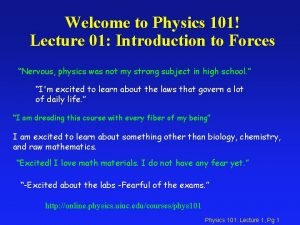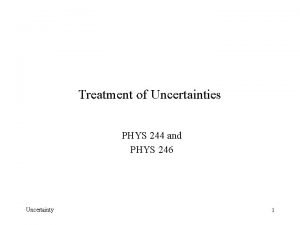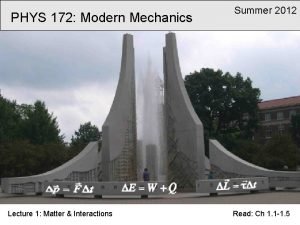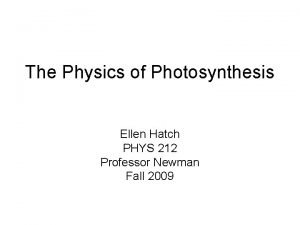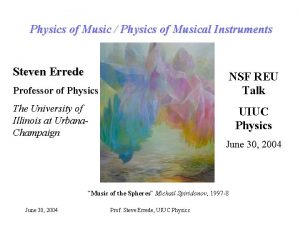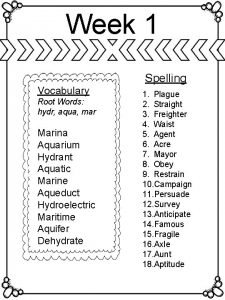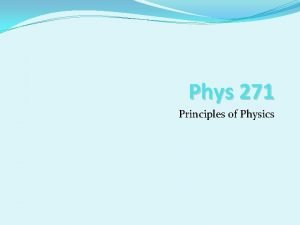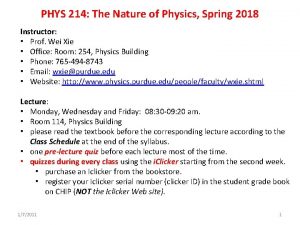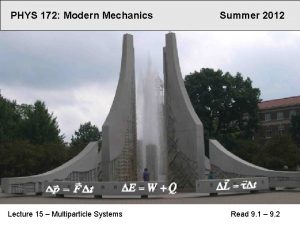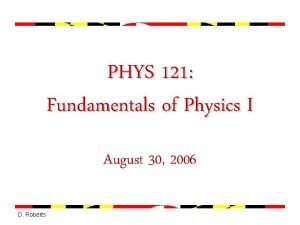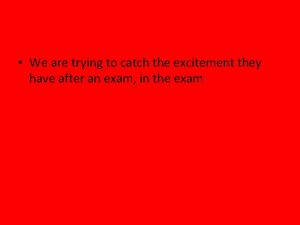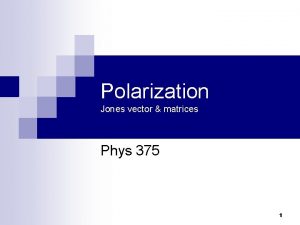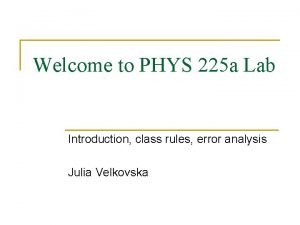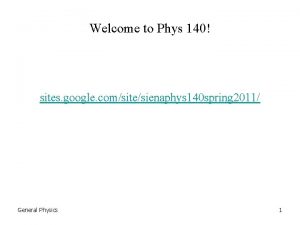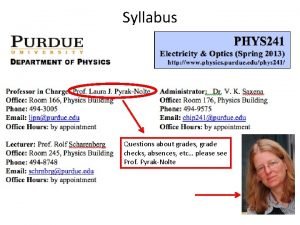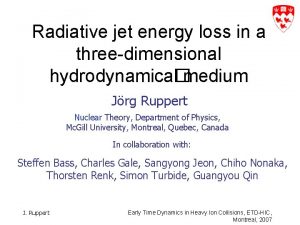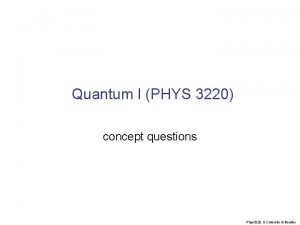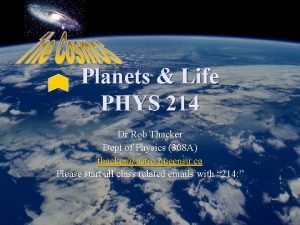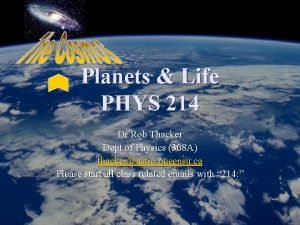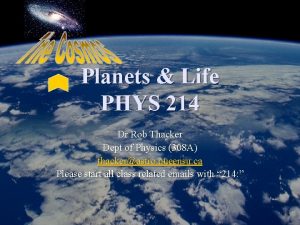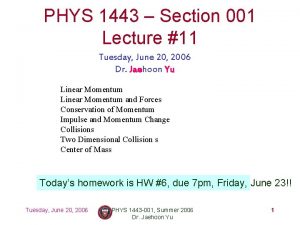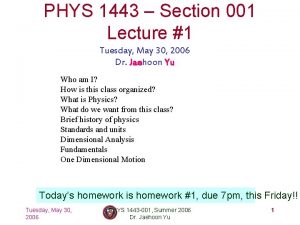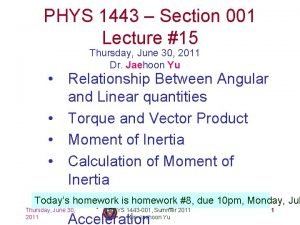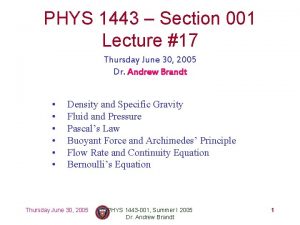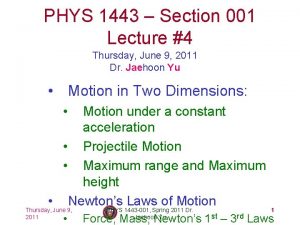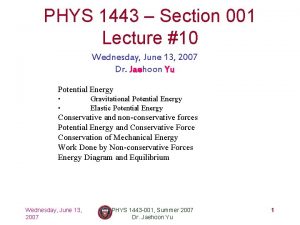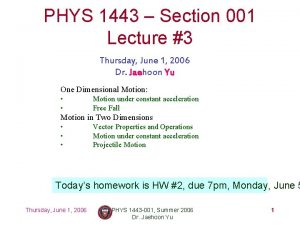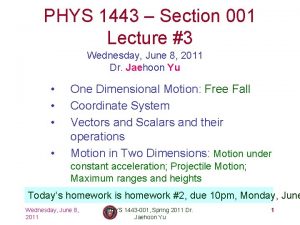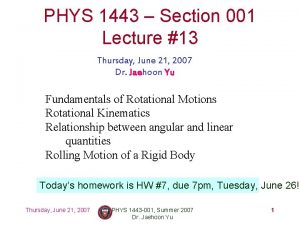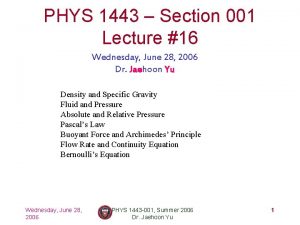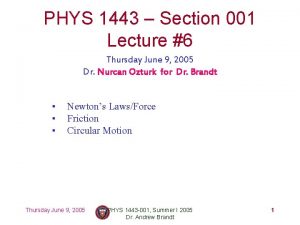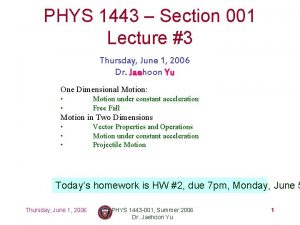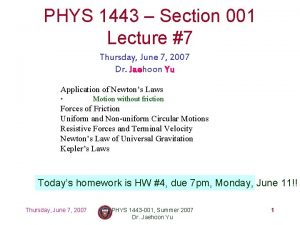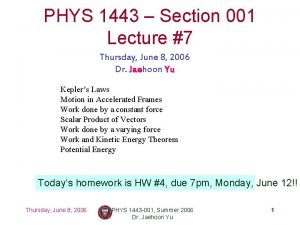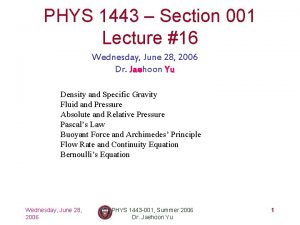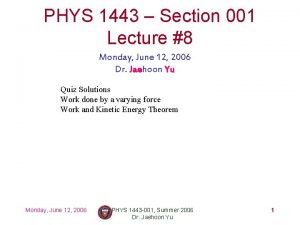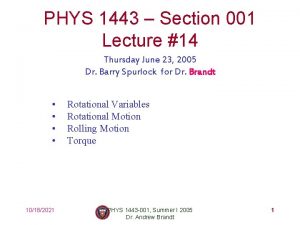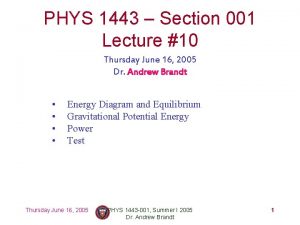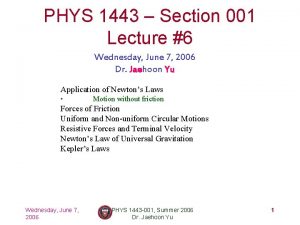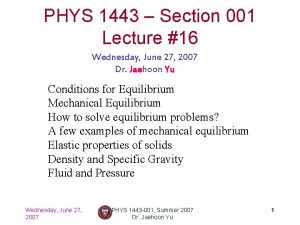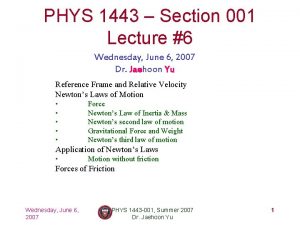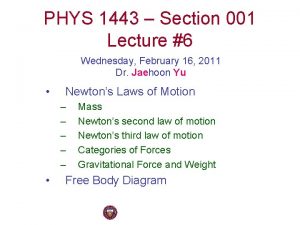PHYS 1443 Section 001 Lecture 2 Tuesday June





![Examples • Show that the expression [v] = [at] is dimensionally correct • Speed: Examples • Show that the expression [v] = [at] is dimensionally correct • Speed:](https://slidetodoc.com/presentation_image_h/0eb7a7c22af621bd6433e08b967279c5/image-6.jpg)























- Slides: 29

PHYS 1443 – Section 001 Lecture #2 Tuesday, June 7, 2011 Dr. Jaehoon Yu • • • Tuesday, June 7, 2011 Dimensional Analysis Fundamentals One Dimensional Motion: Average Velocity; Acceleration; Motion under constant acceleration; Free Fall PHYS 1443 -001, Spring 2011 Dr. Jaehoon Yu 1

Announcements • Homework registration and submissions – 18/27 registered but only 1 submitted the answer! – I will then have to approve your enrollment request • So please go ahead and take an action as soon as possible • The roster closes tomorrow, Wednesday! • Quiz tomorrow at the beginning of the class! – Problems will. PHYS be 1443 -001, on Appendices A and B! Spring 2011 Dr. Tuesday, June 7, 2011 Jaehoon Yu 2

Special Problems for Extra Credit • Derive the quadratic equation for Bx 2 Cx+A=0 5 points • Derive the kinematic equation from first principles and the known kinematic equations 10 points • You must show your work in detail to obtain full credit • Due at the start of the class, Thursday, June 9 Tuesday, June 7, 2011 PHYS 1443 -001, Spring 2011 Dr. Jaehoon Yu 3

Dimension and Dimensional Analysis • An extremely useful concept in solving physical problems • Good to write physical laws in mathematical expressions • No matter what units are used the base quantities are the same – Length (distance) is length whether meter or inch is used to express the size: Usually denoted as [L] – The same is true for Mass ([M])and Time ([T]) – One can say “Dimension of Length, Mass or Time” – Dimensions are treated as algebraic quantities: Can perform two algebraic operations; multiplication or division Tuesday, June 7, PHYS 1443 -001, Spring 2011 Dr. 4 2011 Jaehoon Yu

Dimension and Dimensional Analysis • One can use dimensions only to check the validity of one’s expression: Dimensional analysis – Eg: Speed [v] = [L]/[T]=[L][T-1] • Distance (L) traveled by a car running at the speed V in time T – L = V*T = [L/T]*[T]=[L] • More general expression of dimensional analysis is using exponents: eg. [v]=[Ln. Tm] =[L][T-1] where n = 1 and m = -1 Tuesday, June 7, 2011 PHYS 1443 -001, Spring 2011 Dr. Jaehoon Yu 5
![Examples Show that the expression v at is dimensionally correct Speed Examples • Show that the expression [v] = [at] is dimensionally correct • Speed:](https://slidetodoc.com/presentation_image_h/0eb7a7c22af621bd6433e08b967279c5/image-6.jpg)
Examples • Show that the expression [v] = [at] is dimensionally correct • Speed: [v] =[L]/[T] • Acceleration: [a] =[L]/[T]2 -1 =[L]/[T]= [v] • Thus, = (L/T 2)x. T=LT • Suppose the[at] acceleration a(-2+1) of a=LT circularly moving particle with speed v and radius r is proportional to rn and vm. What are n andm? a r Dimensionless Length constant Tuesday, June 7, 2011 v Speed PHYS 1443 -001, Spring 2011 Dr. Jaehoon Yu 6

Some Fundamentals • Kinematics: Description of Motion without understanding the cause of the motion • Dynamics: Description of motion accompanied with understanding the cause of the motion • Vector and Scalar quantities: – Scalar: Physical quantities that require magnitude but no direction • Speed, length, mass, height, volume, area, energy, heat, etc – Vector: Physical quantities that require both magnitude and direction • Velocity, Acceleration, Force, Momentum • It does not make sense to say “I ran with velocity of 10 miles/hour. ” • Objects can be treated as point-like if their sizes are smaller than the scale in the problem – Earth can be treated as a point like object (or a particle) in celestial problems • Simplification of the 1443 -001, problem. Spring (The 2011 first. Dr. step Tuesday, June 7, PHYS problem…) 2011 Jaehoon Yu in setting up to solve 7 a

Some More Fundamentals • Motions: Can be described as long as the position is known at any given time (or position is expressed as a function of time) – Translation: Linear motion along a line – Rotation: Circular or elliptical motion – Vibration: Oscillation • Dimensions – 0 dimension: A point – 1 dimension: Linear drag of a point, resulting in a line Motion in one-dimension is a motion on a line – 2 dimension: Linear drag of a line resulting in a surface – 3 dimension: PHYS Perpendicular Linear drag of a Tuesday, June 7, 1443 -001, Spring 2011 Dr. surface, resulting in. Jaehoon a stereo object 2011 Yu 8

Displacement, Velocity and Speed One dimensional displacement is defined as: A vector quantity Displacement is the difference between initial and final potions of the motion and is a vector quantity. How is Unit? mthan distance? this different The average velocity is defined as: Unit? m/s A vector quantity Displacement per unit time in the period throughout the motion The average speed is defined as: Unit? m/s Tuesday, June 7, 2011 A scalar quantity PHYS 1443 -001, Spring 2011 Dr. Jaehoon Yu 9

What is the displacement? How much is the elapsed time? Tuesday, June 7, 2011 PHYS 1443 -001, Spring 2011 Dr. Jaehoon Yu 10

Displacement, Velocity and Speed One dimensional displacement is defined as: Displacement is the difference between initial and final potions of the motion and is a vector quantity. How is Unit? mthan distance? this different The average velocity is defined as: Unit? m/s Displacement per unit time in the period throughout the motion The average speed is defined as: Unit? m/s Can someone tell me what the difference between speed and ve Tuesday, June 7, 2011 PHYS 1443 -001, Spring 2011 Dr. Jaehoon Yu 11

Difference between Speed and Velocity • Let’s take a simple one dimensional translation that has many steps: Let’s call this line as X-axis Let’s have a couple of motions in a total time interval of 20 sec. +15 m +10 m -5 m -10 m +5 m -15 m Total Displacement: Average Velocity: Total Distance Traveled: Average Speed: Tuesday, June 7, 2011 PHYS 1443 -001, Spring 2011 Dr. Jaehoon Yu 12

Example 2. 1 The position of a runner as a function of time is plotted as moving along the x axis of a coordinate system. During a 3. 00 s time interval, the runner’s position changes from x 1=50. 0 m to x 2=30. 5 m, as shown in the figure. What was the runner’s average velocity? What was the average speed? • Displacemen t: • Average Velocity: • Average Speed: Tuesday, June 7, 2011 PHYS 1443 -001, Spring 2011 Dr. Jaehoon Yu 13

Instantaneous Velocity and Speed • Can average quantities tell you the detailed NO!! motion? story of the whole • Instantaneous velocity is defined as: – What does this mean? • Displacement in an infinitesimal time interval • Average velocity over a very, very short amount of time • Instantaneous speed is the size (magnitude) of the velocity vector: *Magnitude of Vectors are Expressed in absolute values Tuesday, June 7, 2011 PHYS 1443 -001, Spring 2011 Dr. Jaehoon Yu 14

Instantaneous Velocity Average Velocity Time Tuesday, June 7, 2011 PHYS 1443 -001, Spring 2011 Dr. Jaehoon Yu 15

Position vs Time Plot Position x 1 x=0 It is helpful to understand motions to draw them on position vs time plots. 2 1 t=0 t 1 3 t 2 t 3 time 1. Running at a constant velocity (go from x=0 to x=x 1 in t 1, Displacement is + x 1 in t 1 time interval) 2. Velocity is 0 (go from x 1 to x 1 no matter how much time changes) 3. Running at a constant velocity but in the reverse direction as 1. (go from x 1 to x=0 in t 3 -t 2 time interval, Does this motion physically make Displacement is - x 1 in t 3 -t 2 time interval) sense? Tuesday, June 7, PHYS 1443 -001, Spring 2011 Dr. 16 2011 Jaehoon Yu

Tuesday, June 7, 2011 PHYS 1443 -001, Spring 2011 Dr. Jaehoon Yu 17

Example 2. 3 A jet engine moves along a track. Its position as a function of time is given by the equation x=At 2+B where A=2. 10 m/s 2 and B=2. 80 m. (a) Determine the displacement of the engine during the interval from t 1=3. 0 Displacement is, therefore: (b) Determine the average velocity during this time interval. Tuesday, June 7, 2011 PHYS 1443 -001, Spring 2011 Dr. Jaehoon Yu 18

Example 2. 3 cont’d (c) Determine the instantaneous velocity at t=t 2=5. 00 s. Calculus formula for derivative The derivative of the engine’s equation of motion is The instantaneous velocity at Tuesday, June PHYS 1443 -001, Spring 2011 Dr. t=5. 00 s is 7, 2011 Jaehoon Yu and 19

Displacement, Velocity and Speed Displacement Average velocity Average speed Instantaneous velocity Instantaneous speed Tuesday, June 7, 2011 PHYS 1443 -001, Spring 2011 Dr. Jaehoon Yu 20

Acceleration Change of velocity in time (what kind of quantity. Vector is this? • Definition of the average acceleration: analogous to • Definition of the instantaneous acceleration: analogous to • In calculus terms: The slope (derivative) of the velocity vector with respect to time or the change of slopes of position as a function of time Tuesday, June 7, 2011 PHYS 1443 -001, Spring 2011 Dr. Jaehoon Yu 21

Acceleration vs Time Plot What does this plot tell you? Yes, you are right!! The acceleration of this motion is a constant!! Tuesday, June 7, 2011 PHYS 1443 -001, Spring 2011 Dr. Jaehoon Yu 22

Example 2. 4 A car accelerates along a straight road from rest to 75 km/h in 5. 0 s. What is the magnitude of its average acceleration? Tuesday, June 7, 2011 PHYS 1443 -001, Spring 2011 Dr. Jaehoon Yu 23

• Few Confusing Things on Acceleration When an object is moving in a constant velocity (v=v 0), there is no acceleration (a=0) – Is there any acceleration when an object is not moving? • When an object is moving faster as time goes on, (v=v(t) ), acceleration is positive (a>0). – Incorrect, since the object might be moving in negative direction initially • When an object is moving slower as time goes on, (v=v(t) ), acceleration is negative (a<0) – Incorrect, since the object might be moving in negative direction initially • In all cases, velocity is positive, unless the direction of the movement changes. – Incorrect, since the object might be moving in negative direction initially The answer is YES!! • Is there acceleration if an object moves in a constant speed but changes direction? Tuesday, June 7, PHYS 1443 -001, Spring 2011 Dr. 24 2011 Jaehoon Yu

Displacement, Velocity, Speed & Acceleration Displacement Average velocity Average speed Instantaneous velocity Instantaneous speed Average acceleration Instantaneous Tuesday, June 7, PHYS 1443 -001, Spring 2011 Dr. acceleration 2011 Jaehoon Yu 25

One Dimensional Motion • Let’s focus on the simplest case: acceleration is a constant (a=a 0) • Using the definitions of average acceleration and velocity, we can derive equations of motion (description of motion, velocity and position as a function of time) (If tf=t and ti=0) For constant acceleration, average velocity is a simple numeric average (If tf=t and ti=0) Resulting Equation of Motion becomes Tuesday, June 7, 2011 PHYS 1443 -001, Spring 2011 Dr. Jaehoon Yu 26

Kinematic Equations of Motion on a Straight Line Under Constant Acceleration Velocity as a function of time Displacement as a function of velocities and time Displacement as a function of time, velocity, and acceleration Velocity as a function of Displacement and acceleration You may use different forms of Kinematic equations, depending on the information given to you in specific Tuesday, June 7, problems!! PHYS 1443 -001, Spring 2011 Dr. 27 physical 2011 Jaehoon Yu

How do we solve a problem using a kinematic formula under constant acceleration? • Identify what information is given in the problem. – – Initial and final velocity? Acceleration? Distance, initial position or final position? Time? • Convert the units of all quantities to SI units to be consistent. • Identify what the problem wants • Identify which kinematic formula is most appropriate and easiest to solve for what the problem wants. – Frequently multiple formulae can give you the answer for the quantity you are looking for. Do not just use any formula but use the one that can be easiest to solve. June 7, equations PHYS 1443 -001, Spring 2011 Dr. • Tuesday, Solve the for the quantity or quantities 2011 Jaehoon Yu 28

Example 2. 11 Suppose you want to design an air-bag system that can protect the driver in a head-on collision at a speed 100 km/hr (~60 miles/hr). Estimate how fast the air-bag must inflate to effectively protect the driver. Assume the car crumples upon impact over a distance of about 1 m. How does the use of a seat belt help the driver? How long does it take for the car to come to a full stop? As long as it takes for it to crum The initial speed of the car is and We also know that Using the kinematic formula The acceleration is Thus the time for air-bag to deploy is Tuesday, June 7, 2011 PHYS 1443 -001, Spring 2011 Dr. Jaehoon Yu 29
 Purdue physics 241
Purdue physics 241 01:640:244 lecture notes - lecture 15: plat, idah, farad
01:640:244 lecture notes - lecture 15: plat, idah, farad Uiuc phys 102
Uiuc phys 102 Uiuc physics 101
Uiuc physics 101 Physics courses ucsd
Physics courses ucsd How to calculate percent difference
How to calculate percent difference Phys 172
Phys 172 Single slit envelope
Single slit envelope Optics topics
Optics topics Phys 212 equation sheet
Phys 212 equation sheet Phys 398 uiuc
Phys 398 uiuc Purdue phys 272
Purdue phys 272 Define ostealgia
Define ostealgia Aqua root word meaning
Aqua root word meaning Phys 271
Phys 271 Phys 214
Phys 214 Particl clicker
Particl clicker Phys 121 umd
Phys 121 umd Eosc 111 ubc
Eosc 111 ubc Half wave plate jones matrix
Half wave plate jones matrix Phys 101 uiuc
Phys 101 uiuc Phys 225
Phys 225 Phys140
Phys140 Phys 244
Phys 244 Purdue phys 241
Purdue phys 241 Phys. rev. c
Phys. rev. c Quantumi
Quantumi Phys 214
Phys 214 Phys 214
Phys 214 Phys 214
Phys 214



